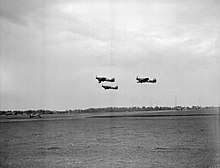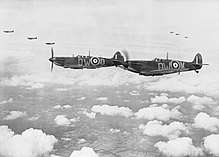Battle of Barking Creek
The Battle of Barking Creek was a friendly fire incident over England on 6 September 1939, resulting in the first death of a British fighter pilot in the Second World War.
Battle

At 6:15 a.m. on 6 September 1939, a radar fault led to a false alarm that unidentified aircraft were approaching from the east at high altitude over West Mersea, on the Essex coast.[1][2] No. 11 Group RAF ordered six Hawker Hurricanes to be scrambled from 56 Squadron, based at North Weald Airfield in Essex. The sector controller, Group Captain David Frederick Lucking, sent up the entire unit of 14 aircraft.[3][4] Unbeknown to the rest of the pilots, two Pilot Officers took up a pair of reserve aircraft and followed at a distance.[5]
Hurricanes from 151 Squadron (also from North Weald), and Supermarine Spitfires from 54, 65 and 74 Squadrons based at Hornchurch Airfield scrambled. None of the Royal Air Force pilots had been in action and few had seen a German aircraft. Communication between the pilots and ground control was poor and there was no procedure for pilots to distinguish between British and Luftwaffe aircraft. Identification friend or foe (IFF) sets were still being developed and had not been installed in many RAF aircraft.[6][4]
With everyone in the air expecting to see enemy aircraft and no experience of having done so, 'A' Flight of 74 Squadron saw what they believed were German aeroplanes and their commander, Adolph "Sailor" Malan, allegedly gave an order to engage. Two of the three, Flying Officer Vincent 'Paddy' Byrne and Pilot Officer John Freeborn, opened fire.[7] Malan later claimed to have given a last minute call of "friendly aircraft – break away!" but if this was true, it was not heard by Byrne and Freeborn.[6] Richard Hough and Denis Richards wrote that further losses were prevented by the 151 Squadron commanding officer, Squadron Leader Edward Donaldson, who alerted his pilots that the attacking aircraft were British and gave the order not to retaliate.[4]
Frank Rose and Pilot Officer Montague Hulton-Harrop were shot down and Hulton-Harrop was killed. Fired upon by John Freeborn, he had been hit in the back of the head and was dead before his Hurricane crashed at Manor Farm, Hintlesham, Suffolk, about 5 mi (8.0 km) west of Ipswich. Hulton-Harrop was the first British pilot killed in the war and his Hurricane was the first aircraft shot down by a Spitfire.[5] A Spitfire was shot down by British anti-aircraft fire.[1]
Aftermath
Court martial

The court martial of John Freeborn and Paddy Byrne at Bentley Priory, the headquarters of Fighter Command, was held in camera. In 2010, the papers had still not been released. According to Bill Nasson in a 2009 publication, it is well known that Freeborn felt that his commanding officer, Sailor Malan, tried to evade responsibility for the attack. Malan testified for the prosecution against his pilots, stating that Freeborn had been irresponsible, impetuous and had not taken proper heed of vital communications.[8] During the trial, Freeborn's counsel, Sir Patrick Hastings, called Malan a bare-faced liar.[6]
The court exonerated both pilots, ruling that the case was an unfortunate accident. In 1990, Hough and Richards wrote,
This tragic shambles, hushed up at the time, was dubbed in the RAF 'the Battle of Barking Creek' – a place several miles from the shooting-down but one which, like Wigan Pier, was a standing joke in the music halls.[4]
In 2003, Patrick Bishop wrote that the incident exposed the inadequacies of RAF radar and identification procedures, leading to their being greatly improved by the time of the Battle of Britain, a view echoed in a 2012 publication by Philip Kaplan.[9][5]
Subsequent careers
Montague Hulton-Harrop is buried with a war grave headstone at St Andrew's Church in North Weald.[10] As an engineering officer who was in the General Duties Branch and could be assigned to non-engineering duties, Lucking was moved.[11][12][13] He was returned to engineering duties later that month as OC (Officer Commanding) 32 MU, transferred to the new Technical Branch in 1940 and was promoted to air commodore in December 1941.[14][15] He died in 1970, aged 75.[16] Frank Rose was killed in action over Vitry-en-Artois, France, on 18 May 1940.[17] Malan went on to be one of the most successful Allied fighter pilots of the war, shooting down 27 Luftwaffe aircraft and rising to group captain. He received the Distinguished Service Order and bar and the Distinguished Flying Cross. On his return to South Africa he worked against the apartheid regime until his death in 1963.[18]
Paddy Byrne was shot down and captured over France in 1940. He was detained at Stalag Luft III with his former defence lawyer Roger Bushell. In 1944 he was repatriated, having convinced the Germans and the repatriation board that he was mad. On his return to England he was reinstated into the RAF and given a ground position.[19] John Freeborn flew more operational hours in the Battle of Britain than any other pilot, remained on operations for the rest of the war and proved to be an outstanding airman. He was awarded the Distinguished Flying Cross and bar and rose to wing commander. Freeborn finally told some of his version of events in a 2002 biography A Tiger's Tale, before co-authoring a more complete account in Tiger Cub.[6][20] In 2009, Freeborn told an interviewer of his regret about Hulton-Harrop's death, saying, "I think about him nearly every day. I always have done... I've had a good life, and he should have had a good life too".[21] Freeborn was twice married, first in 1941 to Rita Fielder, who died in 1979 and then Peta in 1983, who died in 2001. Freeborn died on 28 August 2010 and was survived by a daughter from his first marriage.[22]
See also
- Air attack on the fortress of Koepenick
- Friendly fire incidents of World War II
References
- Terraine 1985, p. 110.
- Yeoman & Freeborn 2009, p. 45.
- Blandford 2001, p. 16.
- Hough & Richards 1990, p. 67.
- Kaplan 2012, p. 51.
- Cossey 2002, chapter 4.
- Bishop 2004, p. 108.
- Nasson 2009, p. 88.
- Bishop 2004, pp. 109–110.
- "Commonwealth War Graves Commission entry". Retrieved 18 August 2010.
- "Air Commodore D F Lucking". rafweb.org. Retrieved 18 March 2017.
- Institution of Mechanical Engineers, Applications for Membership, 1926
- Air Force Lists (HMSO), 1939 and 1940
- "RAF St Athan about us". raf.mod.uk. Archived from the original on 19 March 2017. Retrieved 18 March 2017.
- Air Force Lists (HMSO), 1940 to 1942
- Death notice, The Times, 14 March 1970
- Commonwealth War Graves Commission entry, retrieved 1 September 2010
- Bishop 2004, p. 401.
- Miner Heygood 2010, pp. 9–10.
- Yeoman & Freeborn 2009, chapter 3.
- "Watch: Spitfire pilot John Freeborn's story". BBC. 3 September 2009. Retrieved 18 August 2010.
- "Wing Commander John Freeborn". The Daily Telegraph. London. 14 September 2010. Retrieved 14 September 2010.
Bibliography
Books
- Bishop, Patrick (2004). Fighter Boys (4th ed.). London: Harper Perennial. ISBN 978-0-00-653204-0.
- Blandford, Edmund (2001) [1999]. Fatal Decisions: Errors and Blunders in World War II. Book Sales. ISBN 978-0-7858-1366-8.
- Cossey, Bob (2002). A Tiger's Tale: The Story of Battle of Britain Spitforce ace Wing Commander John Connell Freeborn. Hailsham: J & KH Pub. ISBN 978-1-900511-64-3.
- Holmes, Tony; Azaola, Juan Ramón (1999). Hurricanes to the Fore: The First Aces. Osprey Aircraft of the Aces. 7. Delprado Publishers. ISBN 978-84-8372-221-3.
- Hough, Richard; Richards, Denis (1990) [1989]. The Battle of Britain: The Greatest Air Battle of World War II (W. W. Norton, New York ed.). Hodder & Staughton. ISBN 978-0-393-30734-4.
- Kaplan, P. (2012). Sailor: Battle of Britain Legend Adolph Malan. Barnsley, South Yorks: Pen & Sword Books. ISBN 978-1-78383-033-6.
- Terraine, J. (1998) [1985]. The Right of the Line: The Royal Air Force in the European War 1939–1945 (Wordsworth ed.). London: Hodder and Stoughton. ISBN 978-1-85326-683-6.
- Yeoman, Christopher; Freeborn, John (2009). Tiger Cub – The Story of John Freeborn DFC* A 74 Squadron Fighter Pilot In WWII. Barnsley: Pen and Sword Aviation. ISBN 978-1-84884-023-2.
Journals
- Miner Haygood (PhD, MD), Tamara (2010). "Malingering and Escape: Anglo-American Prisoners of War in World War II Europe" (PDF). War, Literature and the Arts (online ed.). Colorado Springs, CO: Dept. of English of the U.S. Air Force Academy. ISSN 1949-9752. Retrieved 26 August 2010.
- Nasson, Bill (November 2009). "A Flying Springbok of Wartime British Skies: A. G. 'Sailor' Malan" (PDF). Kronos: Journal of Cape History. University of Western Cape, South Africa. 35. ISSN 0259-0190. Retrieved 26 August 2010.
Further reading
- "Fallen Heroes and the Battle of Barking Creek" (PDF). No. 6. Insight Magazine. 2009. Retrieved 26 August 2010. Cite magazine requires
|magazine=(help)